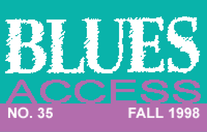
Blue Lu Barker
Taken from the liner notes of the historical album Live At The Jazzfest by Danny and Blue Lu Barker.
The New Orleans Jazz and Heritage Festival will always be an important venue for artists seeking that first crucial spotlight with audiences not otherwise exposed to their music. Most of these musicians tend to be young and starting out. But in the first quarter-century of its grand run, Jazzfest was also a showcase for revitalizing the careers of older musicians who, for various reasons, were less known among younger fans than tried and true aficionados.
Consider Danny and Blue Lu Barker, whose performance at the town's 1989 spring rite is captured on Orleans Records' release Live at the Jazzfest. It was their last joint appearance at the festival and it's more than a cliche to say that the ten tunes recorded that day are a moment caught in time.
Danny was 80. Miss Lu (as the members of Danny's band, the Jazz Hounds, affectionately called her) was 75. The songs span a sweep of vintage American music.
They took the stage to a contagion of applause, a dapper gent with wry wit and the stout Blues diva long married to her teenage sweetheart. Behind them lay an odyssey that straddled the era when Jazz and Blues arose from obscurity in the South to become international art forms. Danny opens with an introduction of "Blue Lu Barker, give her a hand, a little encouragement 'cause she's been ailin'."
She had undergone a tracheotomy sometime before. Danny's guitar licks set an easy tempo on the first tune. Lu sings "Georgia Grid," a staple of the early repertoire of Jazz and Blues. "mama, mama just look at sis/ she's out in the backyard/ shakin' like this/ she's doin' that Georgia Grind...everybody's talkin'."
"You're tryin' to be fast but you don't know how" the lady sings, playing with the lyrics of sexual innuendo - you can practically hear her eyes wink at the suggestiveness. "Mmm, old Uncle Mose/ he's sick in bed/ all the doctor said/ is Nelle dead from doin' the Georgia grind" Poor old Mose indeed, losing his Nellie because she can grind and he can't. Such were intimations of love on the hoof long before television put more graphic language right in your face.
Blue Lu's voice on these cuts has a deep rasp, quite different from the cooing lilt on her 1938 Decca sessions, which marked the debut of a 25-year-old emigre from the Crescent City in New York. back then, she'd been singing her husband's compositions around the house, where she spent most of her time with their 4-year-old, Sylvia.
But then, no aging Blues diva can preserve the voice of youth; time is a cruel master or mistress, as the case may be. What shines through on this release is the character of her voice, a seasoned experience. Even after her vocal chords have taken a hit with throat surgery, Blue Lu glows like a lamp of ages, a flame that won't go out.
Another attraction of Blue Lu and Danny Barker's Live at the Jazzfest is the pleasure of hearing Danny sing once again. When he died in 1994, he left a trail of compositions and a discography that will take years before its range can be grasped. His Jazz funeral that March 17 was among the most memorable ever.
What a life the Barkers led! During the 35 years they lived in New York, Danny did a long stint with Cab Calloway's orchestra. He also recorded with Red Allen, Louis Armstrong, Bunk Johnson, James P. Johnson, and even Bebop pioneer Charlie Parker. In 1948, they spent a long stretch in California, where Lu recorded an album for Capitol. In 1965, with her mother in failing health, they moved back to New Orleans and soon resurrected their careers.
By her own admission, Lu was indifferent to the stage, while Danny, who spent years writing an autobiography and other works, had a deadpan humor and natural showmanship and was ever-willing to seize the moment. In 1973, he coauthored a scholarly study of musical families, Bourbon Street Black, with the sociologist Jack V. Buerkle. In 1986, he published a gem of an autobiography, A Life In Jazz.
Born in the downtown Creole wards, they grew up amidst the flowering of Jazz, a sound that reflected the town in endless ways, from moody reflections on death in "St. James Infirmary"(which Danny massages in satirical vein on this release) to the joystream beat of his uncle Paul Barbarin's classic "Bourbon Street Parade.'
In the struggles black people faced in the early years of the century, the Creole culture of New Orleans was unique. Many of these fair-skinned people of color were descendants of wealthy mulattos who came to the city in the early 1800's, fleeing the slave revolt in Haiti. Some owned slaves and sent children to Paris to study. Many more colored Creoles were artisans - blacksmiths, carpenters, plasterers - who purchased their freedom or worked as free people in the Antebellum era.
By the 1880's, when the Post-Reconstruction political establishment was tightening the screws of segregation, Creoles became leaders of the black political resistance. This society was rooted in a "self-help" culture, with a resistance richly reflected in the constellation of musical families who played a profound role in the shaping of early Jazz.
Danny was born on January 13, 1909, into a storied family of New Orleans music. His maternal grandfather, Isidore Barbarin, played alto horn in the Onward Brass Band; he had three sons who played music, and, as Danny's uncles, they functioned more like older brothers. Paul and Luis, both drummers, were particularly influential. Paul Barbarin, a renowned musician who played with King Oliver and the Creole Jazz band in Chicago, died in 1969, long after resettling in New Orleans. Luis Barbarin, who was a mainstay of the New Orleans style, died earlier this year at the age of 94.
Danny was 17 when he first met 13-year-old Louisa DuPont, whose father ran a grocery store in Treme. She was born November 13, 1913, in the historic Treme neighborhood just outside the French Quarter.
The attraction was immediate, though her parents were concerned about the age difference between them. After an almost Victorian courtship under the watchful eye of Lu's mother and aunts, they married in early 1930, and by the end of that year, with the Depression deepening, had moved to New York where Paul Barbarin helped Danny establish himself as a musician. Before long, he was playing with Jelly Roll Morton.
As he hustled music work, the spirit of the big city seized Danny Barker as it had so many others drawn to its magnetic pulse. "You get to New York," he told me in 1989, "and it's a whole new opening - an inspiration you wouldn't conceive in the South, where when blacks said something, whites looked at you as if you had no foundation. You have an attitude that you're not qualified. So when you get to New York, you have freedom; you meet artists in the Harlem Renaissance. You see Langston Hughes, Countee Cullen and they're talking about their aspirations. Some who were denied in Chicago, which is Midwest and conservative towards blacks, came east to New York. Everybody who aspired to be somebody walked that street in front of Connie's Inn, which was next to the Lafayette Theater, which had first-rate black shows. Between bookings and Vaudeville, people talked about going to Europe like we talk about taking a ferry to Algiers. There was night schools, sculptors and paintings. I'm playing music and hanging around with these people. Your spine sorta stiffens. You saw poems being read, and you think what is this? So I'm reading and lookin' all the time."
Veteran music writer Nat Hentoff called Danny 'one of the best rhythm-section guitarists...it was his Jazz pulse - through the time zones of various Jazz styles - that enabled him to be at home with the singers, boppers, and homeboys."
He carried a tradition in his veins. After they returned to New Orleans, he recorded with the Dirty Dozen, Wynton Marsalis, and Dr. John, among others. His last CD featured Danny on vocals, Save the Bones on Orleans Records.
When Louise Barker went into the studio that first day in 1938 to audition for the Voclain label, Danny couldn't make it because he had another gig, which was no big deal for her. She had grown up singing in the house with her mother and performing in choral groups for yard parties and in Creole halls of Treme. In New York, Danny would spin off compositions so quickly that by the time she got around to singing the tune a day or two later, he'd forgotten the lyrics and was off on another song, or story, or fragment of the autobiography he worked on for many years.
She sang Ella Fitzgerald's "A Tisket A Tasket" at that first audition. When it was done the producer said she needed a professional name. Perplexed, she asked the drummer, Cozy Cole, "What's a professional name?"
"Something short," replied Cole.
"What about Lu Blue?" she replied. The producer nodded.
Danny soon landed her a contract with Decca, and they changed the name to Blue Lu.
The second cut of the release, "Don't You Feel My Legs," was one of the early songs Lu recorded. She'd hummed the melody around the house, and Danny provided the lyrics. The song stirred a controversy when it was released in '38. The lyrics "Don't you feel my legs/ 'cause if you feel my legs/ you'll wanna feel my thighs/ and if you feel my thigh/ you'll wanna go up high/ so don't you feel my legs" were risque for the time, and almost innocent compared to the more graphic, sexual lyrics today. Still, Decca withdrew the recording for a while, which made it all the more popular whenever Lu sang it in clubs in New York.
Now, at the Jazzfest of 1989, she stretched out the memorable lines, "I know there's something you got on your mind/ if you keep drinking/ you're gonna get fresh/ and you'll wind up asking for this fine...brown...flesh!"
The song was also recorded under the title "You Make Me High." Maria Muldaur scored a gold record with a cover of the tune years after the Decca sessions.
"I Wish I Could Shimmy Like My Sister Kate," a tune the young Luis Armstrong wrote and sold cheap for quick money, is a throwback to an older vein of Bluesy dance music, using sweet food as a metaphor for guess what? Blue Lu gives it a gruff yet lyrical flourish: "I wish I could shimmy like my sister Kate/ she shimmies like jelly on the plate...shimmy mmm/ jelly, jelly/ on the plate"
Danny's version of "St. James Infirmary" is one of his most rousing versions of the tragicomedy at Joe's barroom. "Drinks went around as usual/ 'cause a goodly crowd was standing around there/ off in a quiet, dark corner/ with his eyes bloodshot and red - just like mine!/ sat this wise and slick old time, ancient gambler/ these are the words the old man said..."
Barker was a bard, a griot of the culture who gave ballads an epic sense, large events distilled into the tight economy of a tale set to song. Coming from the hospital where his lover lies, he gives a grinning mock moan: "Them slick doctors and double-breasted nurses had her stretched out on a long white table/ she was so pale, she was so fair/ she was so bare lying there/ let her go, let her go/ God bless her/ wherever she may be: up there/ or down below with the devil!"
Not even Armstrong, who made the song famous, had the raucously comedic touch to turn a song so sad into such a raw satire. "Put my hat on because the cinders in the fire may be falling," sings Danny in his unique spin upon mortality. "I want sixteen snow-white horses, not mules, no ponies, no jackasses, all horses!/ sixteen chorus girls from the Ziegfeld Follies/ put a Jazz band on top of my casket, have mercy/ so all my boozehead friends will know I passed away standing pat."
On "Bourbon Street Parade,"Danny's guitar leads the band in the anthem his uncle Paul Barbarin composed, with the nephew's buoyant tenor rolling like a magic ball through poetic lyrics that capture the town at its' best: "Let's fly down/ or drive down/ to New Orleans/ that city, so pretty/ full of historical scenes/ I'm gonna take you/ and parade you/ up and down Bourbon Street/ we're gonna go in all the hot spots/ meet all the big shots/ down on Bourbon Street"
The lines are like a slice out of the lives Danny and Lu led. Taking the train to New York as newlyweds, seeking a wider world of music and wonder, making it in the tough competition of music in the Big Band era, then circling back to the hometown in 1965, when New Orleans was arousing from the cruel slumber of segregation. At an age when many entertainers begin to fade, Danny and Blue Lu remade themselves in the 1970's, becoming symbols of traditional Jazz to an emergent generation of fans who knew little of the music that came out of the streets and churches, the hinky-tonks and parade trails of New Orleans at the turn of the century. To hear them again is a pleasure renewed.
Danny plays guitar on most cuts and banjo on the last one, "Second Line." For roughly fifteen years, until a few months before his death, he played with a group called the Jazz Hounds, led by the mellifluous trumpeter Greg Stafford, with David Grillier playing sweetly on the clarinet and Shannon Powell driving the syncopated beat on drums. Walter Lewis ranges with supple skills on the pain, with Frank Naundorf anchoring harmony on trombone and Edmond Foucher on string bass.
Written by Jason Berry
releases

Blue Lu Barker
Live At The New Orleans Jazzfest
The Georgia Grind / Don't You Feel My Legs /
I Wish I Could Shimmy Like My Sister Kate / Bring the Greenbacks When You Call /
Ballin' the Jack / Save the Bones for Henry Jones / St. James Infirmary /
You Got the Right Key but the Wrong Keyhole / Bourbon Street Parade / Second Line
Originally Released: April 14, 1998 ___________________________________________________________ Blue Lu Barker - Vocals on Tracks 1-5 Danny Barker - Guitar / Banjo, Vocals on Tracks 6-10 Gregg Stafford - Trumpet David Grillier - Clarinet Frank Naundorf - Trombone Walter Lewis - Piano Edmond Foucher - String Bass Shannon Powell - Drums Recorded Live at the 1989 New Orleans Jazz & Heritage Festival “The Georgia Grind” written by Spencer Williams Published by BMI “Don’t You Feel My Legs” written by Blue Lu & Danny Barker and J. Mayo “Ink” Williams Published by Popular Music Co., ASCAP “Wish I Could Shimmy Like My Sister Kate” written by Armand J. Piron Published by Jerry Vogel Music Co. Inc., MCA Music Publishing, ASCAP “Bring the Greenbacks When You Call” written by Blue Lu Barker Published by Attid Music Co., ASCAP “Ballin’ the Jack” written by Christopher Smith & Jim Burris Traditional “Save the Bones for Henry Jones” written by Danny Barker Published by Criterion Music Corp., ASCAP “St. James Infirmary” Traditional “You Got the Right Key But the Wrong Keyhole” written by Clarence Williams and Eddie Green Published by MCA Music Publishing, ASCAP “Bourbon Street Parade” written by Paul Barbarin Published by EMI Unart Catalog Inc., ASCAP “Second Line” written by Paul Barbarin Published by Two Beat Music Corp., BMI Produced by Carlo Ditta Engineered by Mark Bingham Photography by Syndey Byrd Design by Tracy Ste.Marie, Zigzag, New Orleans Special thanks to Quint Davis and the New Orleans Jazz & Heritage Foundation










